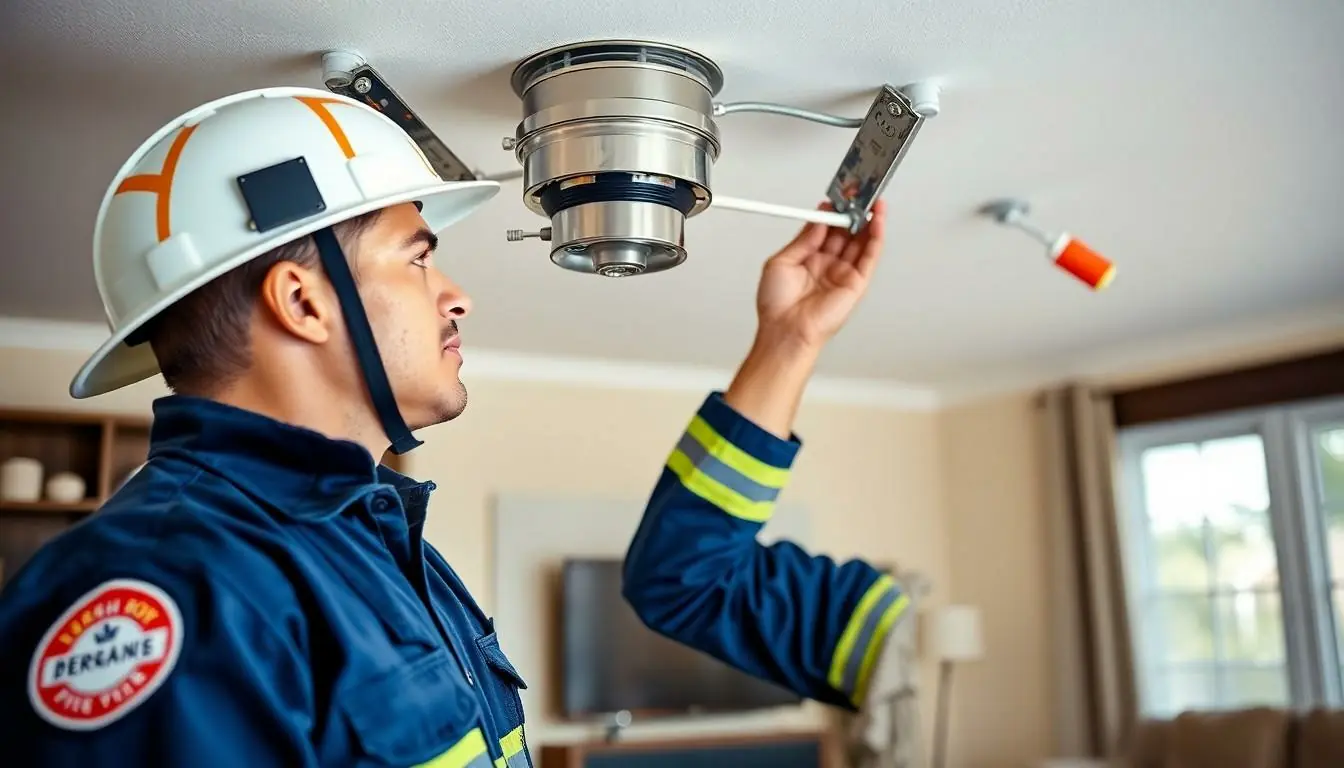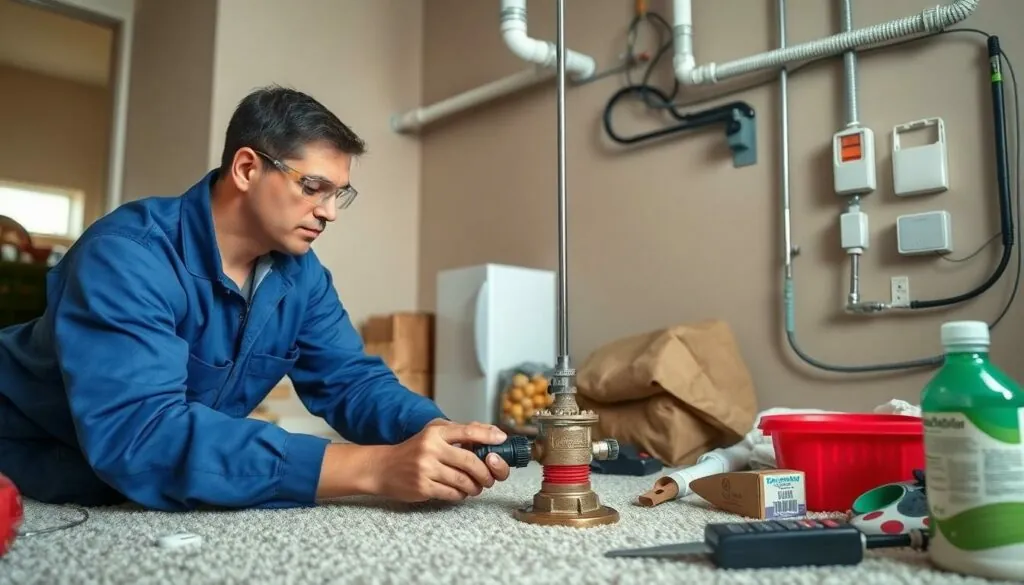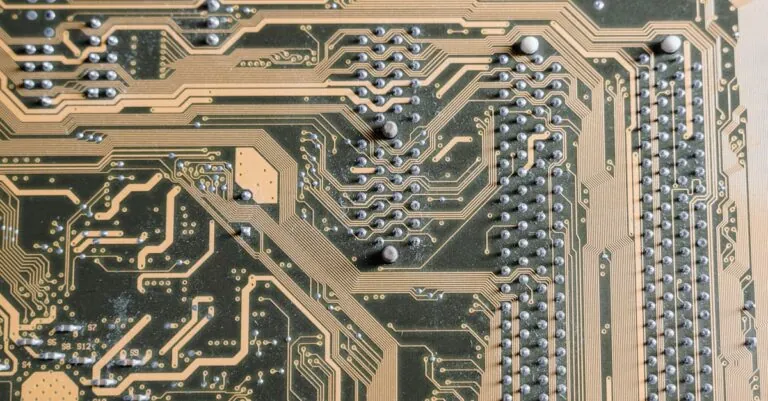When it comes to home safety, fire sprinkler systems are like that reliable friend who always shows up just in time—except this friend needs a little TLC. Regular maintenance of these life-saving systems is crucial, ensuring they’re ready to spring into action when the heat is on. After all, nobody wants to be the star of a “how not to handle a fire” video.
Think of your sprinkler system as a superhero in disguise. It might look unassuming, but with the right care, it can save the day. Neglecting maintenance could turn your trusty sprinkler into a glorified garden hose, leaving you high and dry when flames threaten. So let’s dive into the essentials of keeping your home fire sprinkler system in tip-top shape, because a little upkeep today could mean a safer tomorrow.
Table of Contents
ToggleUnderstanding Home Fire Sprinkler Systems
Home fire sprinkler systems serve as critical components for fire safety, providing timely and effective response to flames. These systems require proper maintenance to function optimally.
Components of a Home Fire Sprinkler System
Home fire sprinkler systems include several key components. Sprinkler heads distribute water when activated. Piping connects the heads to the water supply, ensuring effective flow. Control valves regulate water movement and pressure within the system. Alarm mechanisms notify occupants and emergency services during activation. Each component plays a vital role in the overall effectiveness of the system.
How Fire Sprinklers Work
Fire sprinklers operate through a straightforward mechanism. Temperature-sensitive sensors detect flames, triggering the release of water. Water sprays from the activated sprinkler heads, targeting the fire at its source. While conventional belief suggests all heads activate simultaneously, only those near the fire respond. This targeted approach enhances efficiency and minimizes damage, making fire sprinklers an essential fire protection measure.
Importance of Regular Maintenance

Regular maintenance plays a crucial role in the functionality of home fire sprinkler systems. Ensuring these systems operate at their best enhances overall safety.
Enhancing Safety
Regular inspections of fire sprinkler systems increase safety in homes. Scheduled checks identify issues, ensuring all components, including heads and valves, function properly. Proper maintenance includes cleaning and testing each sprinkler head to prevent clogs and ensure accuracy. Maintenance also ensures that the water pressure remains adequate, which is vital for effective fire suppression. To guarantee maximum protection, homeowners should replace outdated or damaged parts promptly. Consistent upkeep minimizes the risk of failure, providing peace of mind during emergency situations.
Compliance with Local Codes
Following local codes is essential for maintaining home fire sprinkler systems. Each jurisdiction has specific regulations regarding installation and maintenance frequencies. Ignoring these codes risks serious consequences, including fines or, worse, jeopardizing safety. Homeowners must ensure that their systems meet inspection requirements and adhere to proper record-keeping practices. Working with licensed professionals provides reassurance that maintenance aligns with local codes and standards. Compliance not only protects lives but also ensures property value stays intact by adhering to safety regulations.
Maintenance Procedures
Regular maintenance is vital for home fire sprinkler systems to ensure they function effectively during emergencies. Following established procedures helps maintain safety in households.
Visual Inspections
Visual inspections play a key role in sprinkler system maintenance. Inspectors should check for signs of physical damage such as dents or corrosion on sprinklers and pipes. Ensuring adequate clearance around sprinklers prevents obstruction from furniture or decorations. Homeowners must look for leaks in the piping system, as even small leaks can lead to major issues over time. Regular visual check-ups help identify problems early and keep the system ready for activation.
Testing and Maintenance Schedule
Establishing a testing and maintenance schedule is essential for fire sprinkler systems. Inspections should occur at least once a year, but more frequent checks might be necessary in high-risk environments. During these tests, technicians verify that each component, including alarms and control valves, operates correctly. Sprinkler heads need testing for functionality and cleanliness too, as dirt can affect water flow. Following local codes ensures compliance and might require further inspections based on jurisdictional guidelines. Keeping accurate records of testing and maintenance aids in tracking the system’s performance over time.
Troubleshooting Common Issues
Maintaining home fire sprinkler systems involves troubleshooting specific issues that can affect performance. Proper identification and resolution of these problems ensure reliability during emergencies.
Identifying Leaks
Leaks can significantly hamper a fire sprinkler system’s effectiveness. Homeowners should regularly inspect for signs of moisture, which may indicate leakage. Water stains on ceilings or walls often point to a problem. Testing areas around pipe joints and connections can reveal hidden leaks. If leaks are found, timely repair is critical to maintain pressure and ensure optimal functionality. Licensed professionals can provide the necessary expertise for complex repairs.
Addressing Blockages
Blockages can prevent adequate water flow during a fire emergency. Homeowners need to check sprinkler heads and pipes for debris accumulation that might restrict water. Cleaning the sprinkler heads regularly helps maintain unobstructed operation. Flushing the system occasionally removes sediment and buildup within the pipes. Proper maintenance schedules ensure these checks occur routinely, minimizing the risk of blockages. Engaging qualified technicians for thorough inspections and cleaning enhances overall system performance and safety.
Professional Maintenance Services
Regular maintenance of home fire sprinkler systems requires expert attention to ensure optimal function and safety. Engaging professional services guarantees compliance with local codes and regulations.
When to Hire a Professional
Homeowners should consider hiring a professional for maintenance at least once a year. During these scheduled inspections, licensed technicians can thoroughly check the entire system for proper functionality. Immediate assistance is essential if signs of leaks appear. Water stains or moisture around sprinkler heads indicate potential issues that could compromise performance. Engaging professionals also ensures that cleaning and testing procedures follow best practices. When preparing for seasonal inspections, allocate time for technicians to conduct their comprehensive assessments.
Choosing the Right Service Provider
Selecting the right service provider for fire sprinkler maintenance requires careful consideration. Verify the provider’s licensing and certifications to ensure they meet industry standards. Inspect customer reviews and ratings to gauge their reputation for reliability and expertise. Experience in residential fire sprinkler systems is a must when evaluating contractors. Requesting multiple quotes can provide insights into pricing and available services. Communicating clearly about maintenance expectations allows homeowners to establish a solid working relationship. Prioritize service providers known for their customer support and rapid response times.
Regular maintenance of home fire sprinkler systems is essential for ensuring safety and effectiveness. Homeowners must prioritize inspections and upkeep to avoid potential failures during emergencies. By engaging licensed professionals for routine checks and addressing any identified issues promptly, they can significantly enhance the reliability of their systems.
Maintaining accurate records of inspections and repairs not only aids in compliance with local codes but also supports long-term safety. Investing time and resources in the upkeep of fire sprinkler systems ultimately protects lives and property, reinforcing the value of preparedness in fire safety.



